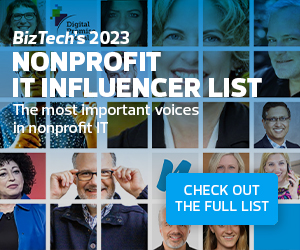In the nonprofit sector, technology continues to drive the way that organizations operate and engage with their communities. These organizations work tirelessly to achieve their missions, often with limited staff and resources. That’s why this year, a cost-optimized technology strategy is key to success.
This means that nonprofit IT leaders should invest in the tech tools that help accelerate an organization’s digital transformation. In fact, nonprofits that are considered “digitally mature” are 4 times more likely to meet mission goals, according to a Salesforce study.
From prioritizing artificial intelligence capabilities that reduce burden on staff to investing in predictive analytics to aid fundraising efforts, these are the tech trends of 2024.
RELATED: These nonprofit tech solutions and services can help your organization.
Trend 1: An Emphasis on Generative AI. Nonprofits are increasingly leveraging generative AI to analyze donor data and predict giving patterns, resulting in more targeted and effective fundraising campaigns. This includes incorporating tools such as AI-powered chatbots and AI-driven analytics into their operations to streamline tasks, improve communication and gain valuable insights.
Generative AI can offer supercharged progress, but getting started means, “enabling transformative, trusted and ethical GenAI deployments across the enterprise,” according to a recent report by EY. Nonprofit experts say that automating repetitive back-office tasks or running faster analysis of donor data saves staff hours of manual work and makes fundraising outreach more effective.
As nonprofits invest in generative AI, they must also establish safeguards. Eric Reicin, CEO of BBB National Programs, tells Forbes, “the stakes for getting AI governance right are high, so organizations should be thinking now about how to navigate policies for its responsible use, both for internal and external audiences.”
LEARN MORE: Artificial intelligence can unlock the full power of your data.
Trend 2: A Push for Data-Driven Decision Making. Organizations that leverage predictive analytics to forecast needs will gain more insights into their communities and refine donor communications. Predictive analytics are helping nonprofits chart future donor behavior based on past contributions. This means that they can target the right donors faster.
“Donors are demanding tangible impacts from their contributions, pushing nonprofits to prove results and the effective use of resources,” Brightpoint President and CEO Mike Shaver tells Forbes.
But to predict success, nonprofits first need to see all of the data that they have available.
“Nonprofits often sit on a trove of historical documentation, databases, applications and other institutional knowledge. But it can be very challenging to efficiently find and leverage that knowledge,” says Jamie Alexandre, the co-founder and executive director of Learning Equality.
That’s why organizations are turning to retrieval-augmented generation, an AI technique that indexes all of these materials in a large language model. “This enables a chat-based way to retrieve, synthesize and interrogate this wealth of organization-specific knowledge,” Turon says.
Click the banner below to view our list of Nonprofit IT Influencers.
Trend 3: A Renewed Focus on Security, Privacy and Trust: With cyberattacks on the rise, there’s a growing emphasis on data ethics and privacy. Nonprofits are investing more in threat and vulnerability assessments “to build trust and retain the continued support of stakeholders,” Shaver says.
Now more than ever, users are aware of scams and suspicious of robocalls. “An inauthentic thank you letter written by a chatbot or a security breach by an AI data screening service will undermine trust in the affected organization and the entire sector,” Benefactor Group President Laura MacDonald tells Forbes.
Trend 4: A Commitment to Sustainability: According to the Environmental and Energy Study Institute, energy is one of the highest operational expenses for nonprofits. Programs such as the Renew America’s Nonprofits Program, launched in 2022 by the Biden administration, fund widespread energy improvements so nonprofits can generate savings.
Reducing e-waste, improving data center efficiency, and prioritizing IT asset management and IT asset disposition strategies are all important steps as nonprofits prioritize sustainability initiatives.
Overall, 2024 promises a seismic shift as nonprofits use generative AI and predictive analytics to enhance their operations and digitally mature. IT leaders who integrate new tech into their organizations thoughtfully and transparently will be the most successful at retaining the trust of their teams and donors.











